Dear Aspirants, Our IBPS Guide team is providing new pattern Reasoning Questions for IBPS PO Mains 2019 so the aspirants can practice it on a daily basis. These questions are framed by our skilled experts after understanding your needs thoroughly. Aspirants can practice these new series questions daily to familiarize with the exact exam pattern and make your preparation effective.
Check here for IBPS PO Mains Mock Test 2019
Data sufficiency
Directions (1-4): Each of the questions below consists of a question and two statements numbered I and II given below it. You have to decide whether the data provided in the statements are sufficient to answer the question:
a) If the data in Statement I alone is sufficient to answer the question, while the data in Statement II alone is not sufficient to answer the question.
b) If the data in Statement II alone is sufficient to answer the question, while the data in Statement I alone is not sufficient to answer the question.
c) If the data either in Statement I alone or in Statement II alone is sufficient to answer the question.
d)If the data in both the Statements I and II together are not sufficient to answer the question.
e) If the data in both the Statements I and II together are necessary to answer the question.
1) Seven books of different subjects viz. Math, English, Science, Hindi, History, GK and Geography having different cover says Red, Green, Blue, Black, White, Yellow and Pink are kept one above other on the self then, then how many books is/are kept between Yellow covered book and Science book?
I) Geography is kept at bottom having pink cover. There is a gap of one place between English and Hindi, who has cover of Green color. Math is at second position from top. Book having Red cover is kept at the top. English having Blue cover is above Hindi. History book is kept just below math book.
II) Science is kept third from bottom just below English having Blue cover. GK book is kept on top at a gap of one place from History book. Science book having Black cover is kept at any place below Math book. Geography book having Pink cover is kept at any place below Hindi book.
2) Eight friends P, Q, R, S, T, U, V and W sitting in a circular table facing center each having different hobby viz. Painting, Boxing, Singing, Badminton, Drawing, Singing, Cricket and Football then, what is the hobby of the person who sit second to right of the one having Cricket as hobby?
I) U sits third to right of T, who likes Singing. Q having Boxing as hobby sits second to right of R, who sits third to right of S. V sits third to right of one likes Dancing, who sits second to right of P. The one who likes singing sits second to left of the one like Drawing. S sits immediate left of U. The one who likes Football sit in-front of the one who likes Badminton, who sits third to left of T. P sits third to left of Q.
II) The one likes Boxing sits immediate right of W. Q sits third to left of S, who sits second to right of the one who likes Singing. U sits second to left of R, who sits second to left of the one who likes Boxing. The one who likes Dancing sits third to right of the one likes Painting, who sits second to right of V. P sits third to left Q, who like Boxing. T likes Singing and sits third to left of the one who likes Cricket.
3) In row seven person namely – P, Q, R, S, T and U sits in a row in such a way that some are facing north while other sits facing south, then how many person sits facing south?
I) S sits third to right of R. Neither S nor R sits at end of the row. T sits second to left of P and sits facing opposite direction of S. Two person sits between Q and P, who neither sits at end nor sits adjacent to R.
II) P sits second to right of T. Either of them sits at end of the row. U and P doesn’t sit together. S sits third to right of R, who sits facing south. U sits second to left of Q, who sits immediate left of R.
4) In a family of six members each person works in different organization viz. RBI, TCS, SBI, PNB, Wipro and HP, then in which organization W’s father Works?
I) The one who works in TCS is unmarried sister of H, who works in Wipro. The one who works in HP is married to J and is daughter-in-law of M. D is one of the married member of the family. The one who works in RBI is married to H and is sister-in-law of P. The one who works in SBI is son of J.
II) W is grandson of the one who works in RBI. J is only child of the one who is brother of P. The one who works in HP is mother of the one who works in SBI. H is married to M. J is father of W and is married to the one who works in HP. M is sister-in-law of P, who works in TCS. H neither works in RBI nor PNB.
Puzzle
Directions (5-7): Study the following information carefully and answer the below questions.
There are eight members in a family. Each likes different fruits viz. Guava, Apple, Mango, Banana, Papaya, Cheery, Litchi and Orange. Each person also has different number of 2 coins. B has 121 coins, she takes 18 coins and give remaining to her only son, who likes Mango. The one who likes Cheery takes 3/8thof coin from G. The one who likes Apple is sibling of R, who is mother of the one who likes Orange. K gives 56 coins to G, who is unmarried member of the family. M, who likes Mango, takes 12 coins and gives the remaining to his nephew H. Difference of value of coin from K to E is less than 4. The one who likes Cheery is only married child of B, who likes Banana. H takes 8 coins and gives the rest to his father who likes Litchi. The one who likes Guava is married to the one who likes Orange. P is one of the male members of the family. The one who likes Papaya is married to B and takes remaining 72 coins from the one who likes Litchi. Three married couples are there in the family. R gives 2/3rd of coin to her daughter-in-law.
5) How the one who has 8 coins is related to the one who likes Apple?
a) Grandson
b) Brother-in-law
c) Niece
d) Son-in-law
e) None of these
6) What is the square root of amount the one who likes Papaya and how is the one who likes Papaya is related to P?
a) 4, mother-in-law
b) 4√2, Maternal Grandfather
c) 4√3, Father-in-law
d) 3√2, Sister-in-law
e) None of these
7) How E is related to the one who likes Cheery?
a) Daughter-in-law
b) Grandson
c) Father-in-law
d) Sister-in-law
e) None of these
Coding-Decoding
Directions (8-10): Study the following information carefully and answer the below questions.

Conditions:
i) If the first element is an even number and the last element is a consonant, then their codes are to be interchanged.
ii) If the first element is a consonant and the last element is a prime digit then codes of third and fifth element are to be interchanged.
iii) If both the first and the last element is a number, then both are to be coded as the code for the first digit.
iv) If both the second and the seventh element are an odd number, then fourth element is coded as ‘₹’.
v) If fourth element is followed by vowel, then code of both second and sixth element are coded as code of second element.
vi) If first element is a vowel and last element is a consonant, then both element is coded as code of last element.
8) What is code for “H7J5UQE2”?
a)&Y$Z%$^B
b) &Y$Z%Y^B
c) &Y$Z&Y^B
d) &Y$Z$%YB
e) None of these
9) What is code for “E3V8AH9Q”?
a)£T@₹#XT£
b)£X₹@#XT£
c) £X@₹X#T£
d) £X@₹#&T£
e) None of these
10) What is code for “U2HVEP59”?
a)TB&₹^BZ$
b)$&B₹^BZT
c) $B&₹^ZBT
d) $B&₹^BZT
e) None of these
Answers :
Directions (1-4) :
1) Answer: D
From I:
We have:
- Geography is kept at bottom having pink cover.
- Math is at second position from top.
- Book having Red cover is kept at the top.
- History book is just placed below math book.
- There is a gap of one place between English and Hindi, who has cover of Green color.
- English having Blue cover is above Hindi, that means English book is kept just below History book.
Based on above given information we have:
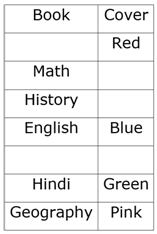
Clearly, no exact position for science book is known.
Hence, statement I is not sufficient alone.
From II:
We have:
- Science is kept third from bottom just below English having Blue cover.
- GK book is kept on top at a gap of one place from History book.
- Science book having Black cover is kept at any place below Math book.
- Geography book having Pink cover is kept at any place below Hindi book, that means Geography book is kept at bottom.
Based on above given information we have:
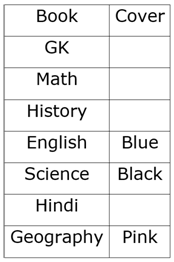
Clearly, exact position Yellow covered book is not known.
Hence, statement II is not sufficient alone.
From I and II:
After combining statement I and II we have:
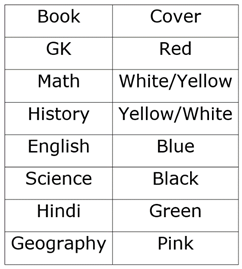
Clearly, exact position of Yellow covered book is not known.
Hence, statement I and II together not sufficient.
Hence, option D is correct choice.
2) Answer: E
From I:
We have:
- U sits third to right of T, who likes Singing.
- S sits immediate left of U.
- The one who likes Football sit in-front of the one who likes Badminton, who sits third to left of T, that means the one who likes Football sits immediate left of S.
- Q having Boxing as hobby sit second to right of R, who sit third to right of S, that means R likes Badminton.
- P sit third to left of Q.
- V sit third to right of one likes Dancing, who sit second to right of P, which means V likes Football.
- The one who likes singing sits second to left of the one like Drawing, that means S likes Drawing.
Based on above given information we have:
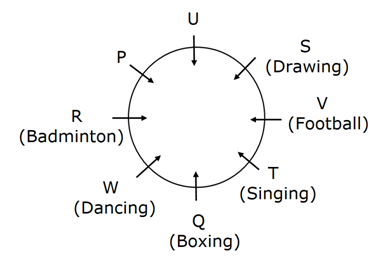
Clearly, we don’t know exact position of the one whose hobby is Cricket.
Hence, statement I is not sufficient alone.
From II:
We have:
- Q sits third to left of S, who sits second to right of the one who likes Singing.
- P sits third to left Q, who like Boxing.
- The one who likes Football sit third to left of P.
- U sits second to left of R, who sits second to left of the one who likes Boxing.
- The one likes Boxing sits immediate right of W.
- T likes Singing and sits third to left of the one who likes Cricket, that means U likes Cricket.
Based on above given information we have:
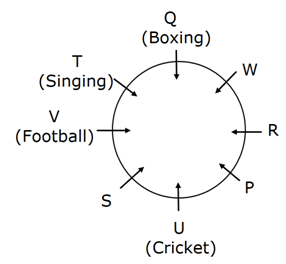
Clearly, we don’t know hobby of the R, who sits second to right of the one who likes Cricket.
Hence, statement II is not sufficient alone.
From I and II:
After combining both statements we have:
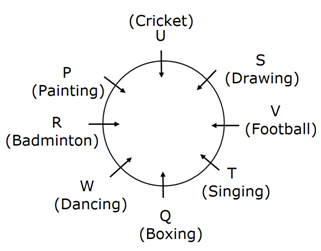
Clearly, R (Badminton) sits second to right of U (Cricket).
Hence, Statement I and II together sufficient.
Hence, option E is correct choice.
3) Answer: D
From I:
- S sits third to right of R.
- Neither S nor R sits at end of the row, that means we have two possible place for S, in case (1) S sits second from left end, in case (2) S sits second from right end.
- Two person sits between Q and P, who neither sits at end nor sits adjacent to R.
- T sits second to left of P and sits facing opposite direction of S.
Based on above given information we have:

Clearly, direction of facing of T, S, U and Q is not known.
Thus, required result can’t be determined.
Hence, statement I is not sufficient alone.
From II:
We have:
- P sits second to right of T.
- Either of them sits at end of the row, that means we have we have four possible place for P, in case (1) P sits at left end, in case (2) P sits third from left end, in case (3) P sits at right end, in case (4) P sits third from right end.
- S sits third to right of R, who sits facing south, that means R sits second from right end.
- U sits second to left of Q, who sits immediate left of R, that means case (3) & case (4) are not valid.
- U and P doesn’t sit together, that means case (2) is not valid.
Based on above given information we have:
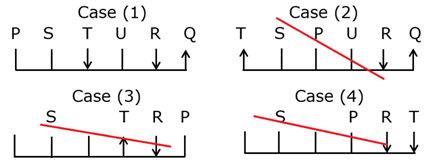
Clearly, direction of facing of P, S and U are not known.
Thus, result can’t be determined.
Hence, statement II is not sufficient alone.
From I and II:
Clearly, both the statements are independent statement as P sits on end of row in statement II which contradict statement I.
Thus, we can’t compare both statements.
Hence, statement I and II together are not sufficient.
Hence, option D is correct choice.
4) Answer: A
From I:
We have:
- The one who works in TCS is unmarried sister of H, who works in Wipro.
- The one who works in RBI is married to H and is sister-in-law of P, that means P works in TCS.
- The one who works in HP is married to J and is daughter-in-law of M.
- The one who works in SBI is son of J, as only six members are there in family, that means M must be married to H and J is son of M.
- D is one of the married member of the family, that means D must married to J.
- As, only left organization is PNB, thus J must works in PNB.
Based on above given information we have:
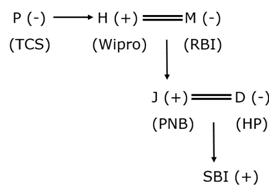
Clearly, J works in PNB, who is father of the one who works in SBI.
Hence, statement I alone is sufficient.
From II:
We have:
- J is father of W and is married to the one who works in HP, that means the one who works in HP is mother of W.
- J is only child of the one who is brother of P.
- M is sister-in-law of P, who works in TCS, that means M must be mother of J.
- The one who works in HP is mother of the one who works in SBI, that means W works in SBI.
- W is grandson of the one who works in RBI.
- H is married to M.
- H neither works in RBI nor PNB, that means M must work in SBI.
Based on above given information we have:

Clearly, organization of J is not known.
Hence, statement II alone is not sufficient.
Directions (5-7):
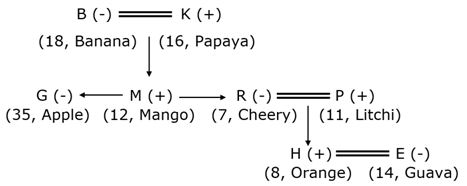
We have:
- B has 121 coins, she takes 18 coins and give remaining to her only son, who likes Mango, that means B is mother of the one who likes Mango.
- M, who likes Mango takes 12 coins and gives the remaining to his nephew H, that means number of coins to H is 95.
- H takes 8 coins and gives the rest to his father who likes Litchi, that means number of coins to the one who likes Litchi is 83.
- The one who likes Papaya is married to B and takes remaining 72 coins from the one who likes Litchi, since B is married to the one who likes Papaya, that means the one who likes Papaya is father of M and remaining coin with the one who likes Litchi is 11.
- The one who likes Cheery is only married child of B, who likes Banana, since the one who likes Cheery is only married child of B and M is only son of B, thus the one who likes Cheery is mother of H.
Based on above given information we have:
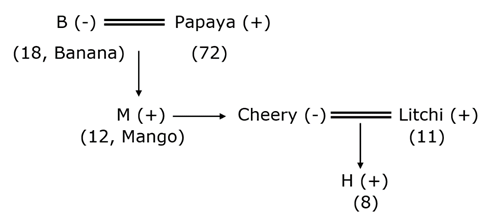
Again, we have:
- The one who likes Apple is sibling of R, who is mother of the one who likes Orange.
- R gives 2/3rd of coin to her daughter-in-law.
- The one who likes Guava is married to the one who likes Orange, as only three married couples are there in family of eight members, thus R must likes Cheery and H likes Orange.
- K gives 56 coins to G, who is unmarried member of the family, that means G must likes Apple and K likes Papaya.
- Since K gives 56 coins to that means K has 16 coins remaining.
- The one who likes Cheery takes 3/8th coin from G, that means remaining coin with G is 35.
- Since, R gives 2/3rd of coin to her daughter-in-law, that means the one who likes Guava has 14 coins.
- Difference of value of coin from K to E is less than 4, that means E must have 14 coins.
- P is one of the male member of the family, that means P must married to R.
Based on above given information we have final arrangement as follow:
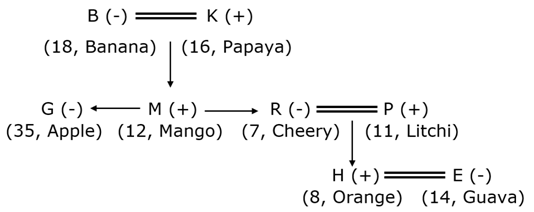
5) Answer: E
Clearly, the one who has 8 coins is Nephew of the one who likes Apple.
Hence, option E is correct choice.
6) Answer: E
Clearly, total coin to the one who likes Papaya = 16.
Thus, required square root = √16= 4.
The one who likes papaya is father-in-law of P.
Hence, option E is correct choice.
7) Answer: A
Clearly, E is daughter-in-law of the one who likes Cheery.
Hence, option A is correct choice.
Directions (8-10):
8) Answer: B
We have: “H7J5UQE2”.
After applying condition II, we have:
H7$5%QE2
Again, after applying condition V, we have:
&Y$Z%Y^B
Thus, required code = “&Y$Z%Y^B”.
Hence, option B is correct choice.
9) Answer: E
We have: “E3V8AH9Q”.
After applying condition IV, we have:
E3V₹AH9Q
Again, after applying condition V, we have:
EXV₹AX9Q
Again, after applying condition VI, we have:
£XV₹AX9£
Thus, required code = “£X@₹#XT£”.
Hence, option E is correct choice.
10) Answer: D
We have: U2HVEP59
After applying condition IV, we have:
U2H₹EP59
Again, after applying condition V, we have:
UBH₹EB59
Thus, required code = “$B&₹^BZT”.
Hence, option D is correct choice.





